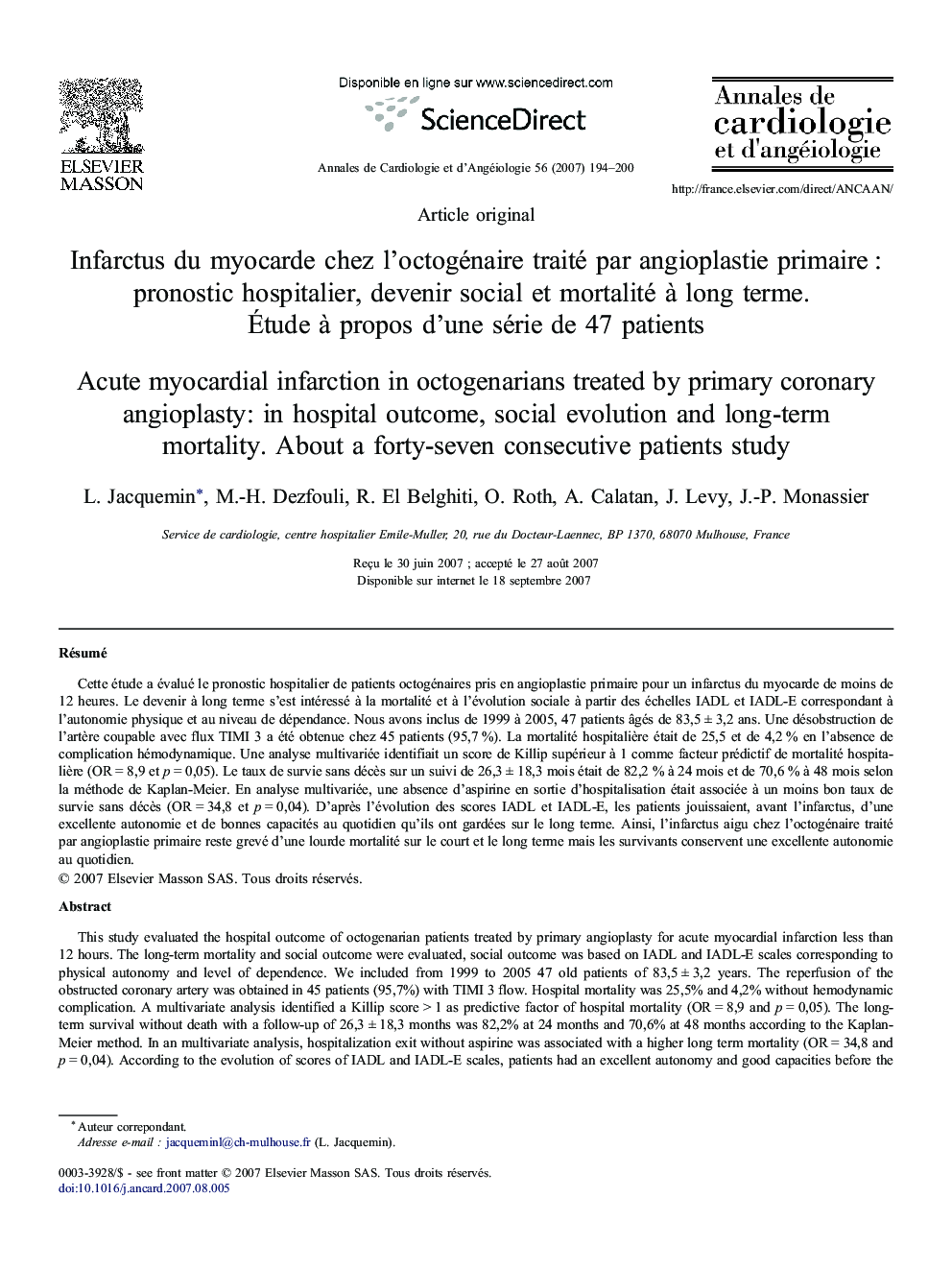| Article ID | Journal | Published Year | Pages | File Type |
|---|---|---|---|---|
| 2869636 | Annales de Cardiologie et d'Angéiologie | 2007 | 7 Pages |
RésuméCette étude a évalué le pronostic hospitalier de patients octogénaires pris en angioplastie primaire pour un infarctus du myocarde de moins de 12 heures. Le devenir à long terme s'est intéressé à la mortalité et à l'évolution sociale à partir des échelles IADL et IADL-E correspondant à l'autonomie physique et au niveau de dépendance. Nous avons inclus de 1999 à 2005, 47 patients âgés de 83,5 ± 3,2 ans. Une désobstruction de l'artère coupable avec flux TIMI 3 a été obtenue chez 45 patients (95,7 %). La mortalité hospitalière était de 25,5 et de 4,2 % en l'absence de complication hémodynamique. Une analyse multivariée identifiait un score de Killip supérieur à 1 comme facteur prédictif de mortalité hospitalière (OR = 8,9 et p = 0,05). Le taux de survie sans décès sur un suivi de 26,3 ± 18,3 mois était de 82,2 % à 24 mois et de 70,6 % à 48 mois selon la méthode de Kaplan-Meier. En analyse multivariée, une absence d'aspirine en sortie d'hospitalisation était associée à un moins bon taux de survie sans décès (OR = 34,8 et p = 0,04). D'après l'évolution des scores IADL et IADL-E, les patients jouissaient, avant l'infarctus, d'une excellente autonomie et de bonnes capacités au quotidien qu'ils ont gardées sur le long terme. Ainsi, l'infarctus aigu chez l'octogénaire traité par angioplastie primaire reste grevé d'une lourde mortalité sur le court et le long terme mais les survivants conservent une excellente autonomie au quotidien.
This study evaluated the hospital outcome of octogenarian patients treated by primary angioplasty for acute myocardial infarction less than 12 hours. The long-term mortality and social outcome were evaluated, social outcome was based on IADL and IADL-E scales corresponding to physical autonomy and level of dependence. We included from 1999 to 2005 47 old patients of 83,5 ± 3,2 years. The reperfusion of the obstructed coronary artery was obtained in 45 patients (95,7%) with TIMI 3 flow. Hospital mortality was 25,5% and 4,2% without hemodynamic complication. A multivariate analysis identified a Killip score > 1 as predictive factor of hospital mortality (OR = 8,9 and p = 0,05). The long-term survival without death with a follow-up of 26,3 ± 18,3 months was 82,2% at 24 months and 70,6% at 48 months according to the Kaplan-Meier method. In an multivariate analysis, hospitalization exit without aspirine was associated with a higher long term mortality (OR = 34,8 and p = 0,04). According to the evolution of scores of IADL and IADL-E scales, patients had an excellent autonomy and good capacities before the infarction and they kept them on the long term. Thus octogenarians with acute myocardial infarction treated by primary angioplasty have a high in hospital and long term mortality but the survivors preserve an excellent daily autonomy.
